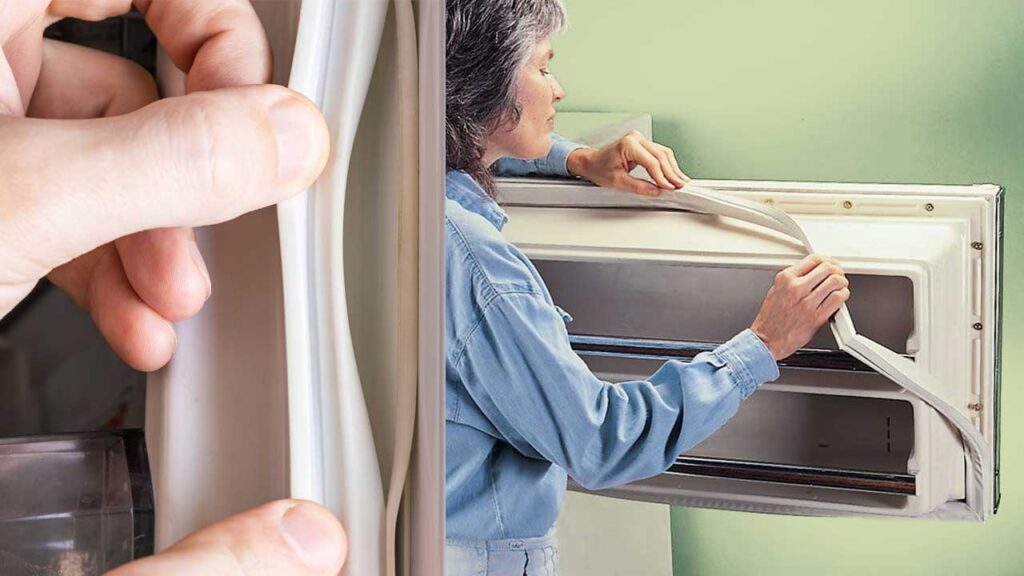A refrigerator door seal, also known as a gasket, is a rubber strip that surrounds the door and creates an airtight seal when the door is closed. This seal prevents cold air from escaping and warm air from entering the refrigerator, which helps to maintain the optimal temperature and humidity for food preservation.
However, over time, the door seal can get damaged, torn, or worn out due to various factors, such as age, usage, dirt, mold, or misalignment. A faulty door seal can cause several problems, such as:
- Higher energy bills due to the refrigerator working harder to keep the temperature constant
- Spoiled food due to temperature fluctuations and bacterial growth
- Frost buildup and ice formation inside the freezer compartment
- Water leakage and condensation on the floor or shelves
Therefore, it is important to check and fix your refrigerator door seal as soon as you notice any signs of damage or malfunction. In this article, we will show you how to repair a torn refrigerator door seal in a few simple steps. We will also provide some tips on how to prevent future damage and extend the lifespan of your door seal.
What You Will Need
To repair a torn refrigerator door seal, you will need the following tools and materials:
- A screwdriver (preferably a Phillips head)
- A silicone sealant
- A wax paper
- A pair of scissors
- A damp cloth or sponge
- A dry towel
If you need to replace the door seal entirely, you will also need:
- A new door seal that matches your refrigerator model (you can find it online or at a local appliance store)
- A utility knife
How to Repair a Torn Refrigerator Door Seal?
Before you start repairing your refrigerator door seal, make sure to unplug your refrigerator from the power source and remove any food items from the door shelves. This will prevent any electrical shocks and make the repair process easier.
Follow these steps to repair a torn refrigerator door seal:
- Locate the tear in the door seal. Inspect the entire seal for any other cracks or holes that may need fixing.
- Lift up the edge of the door seal and find the screws that hold it in place. Use a screwdriver to loosen them slightly, but do not remove them completely.
- Peel off the door seal from the door frame. Be careful not to damage it further or pull too hard.
- Cut a piece of wax paper that is slightly larger than the tear in the door seal. Slide it into the fold of the seal where the tear is located. This will prevent the silicone sealant from sticking to the other side of the seal.
- Apply a thin layer of silicone sealant over the tear and press it firmly with your fingers. Make sure to fill in any gaps or holes in the seal.
- Let the silicone sealant dry for at least 24 hours or according to the manufacturer’s instructions.
- Remove the wax paper from the door seal and trim any excess silicone with a pair of scissors.
- Reattach the door seal to the door frame by sliding it back into place and tightening the screws.
- Wipe off any dirt or residue from the door seal with a damp cloth or sponge and dry it with a towel.
- Plug in your refrigerator and check if the door closes properly and creates an airtight seal.
How to Replace a Refrigerator Door Seal?
If your refrigerator door seal is too damaged or worn out to be repaired, you may need to replace it with a new one. This can be more challenging than repairing it, but it is still doable with some patience and care.
Follow these steps to replace a refrigerator door seal:
- Unplug your refrigerator from the power source and remove any food items from the door shelves.
- Lift up the edge of the old door seal and find the screws that hold it in place. Use a screwdriver to remove them completely and set them aside.
- Peel off the old door seal from the door frame and discard it.
- Clean the door frame with a damp cloth or sponge and dry it with a towel.
- Take out the new door seal from its packaging and inspect it for any defects or damages.
- Align the new door seal with the door frame and make sure it fits snugly and evenly.
- Secure the new door seal to the door frame by inserting and tightening the screws that you removed earlier.
- Trim any excess rubber from the new door seal with a utility knife if needed.
- Plug in your refrigerator and check if the door closes properly and creates an airtight seal.
Tips on How to Prevent Damage to Your Refrigerator Door Seal
To avoid having to repair or replace your refrigerator door seal frequently, you can follow some simple tips to prevent damage and extend its lifespan. Here are some of them:
- Clean your door seal regularly with a mild soap and water solution and dry it thoroughly. This will remove any dirt, grease, or mold that can cause the seal to deteriorate or lose its elasticity.
- Avoid slamming or yanking the door open or closed. This can cause the seal to stretch or tear over time. Instead, open and close the door gently and smoothly.
- Check the alignment and balance of your refrigerator. If your refrigerator is tilted or uneven, it can affect the way the door closes and put pressure on the seal. Adjust the feet or legs of your refrigerator to make sure it is level and stable.
- Replace your door seal every 5 to 10 years or as needed. Even with proper care and maintenance, your door seal will eventually wear out and lose its effectiveness. Replacing it with a new one will ensure that your refrigerator operates efficiently and safely.
FAQ
Here are some common questions and answers about refrigerator door seals that you may find helpful.
How to fix a refrigerator door seal?
To fix a refrigerator door seal, you need to first identify the problem and then apply the appropriate solution. If the door seal is dirty or has debris, you can clean it with warm soapy water and a soft cloth. If the door seal is torn or cracked, you can repair it with silicone sealant and wax paper. If the door seal is warped or worn out, you need to replace it with a new one that matches your refrigerator model. For more details, please refer to the previous sections of this article.
How often should I replace my refrigerator door seal?
There is no definitive answer to this question, as it depends on various factors, such as the age, usage, and condition of your refrigerator and its door seal. However, a general rule of thumb is to replace your refrigerator door seal every 5 to 10 years or as needed. You can check the signs of a faulty door seal, such as higher energy bills, spoiled food, frost buildup, water leakage, or condensation, and replace it accordingly.
How much does it cost to replace a refrigerator door seal?
The cost of replacing a refrigerator door seal can vary depending on the type, size, and brand of your refrigerator and its door seal. According to some online sources , the average cost of a new refrigerator door seal ranges from $30 to $100, while the average cost of labor ranges from $100 to $200. Therefore, the total cost of replacing a refrigerator door seal can range from $130 to $300.
How do I prevent damage to my refrigerator door seal?
To prevent damage to your refrigerator door seal, you can follow some simple tips, such as:
- Clean your door seal regularly with a mild soap and water solution and dry it thoroughly.
- Avoid slamming or yanking the door open or closed.
- Check the alignment and balance of your refrigerator.
- Replace your door seal every 5 to 10 years or as needed.
For more tips, please refer to the previous section of this article.
Fixing a refrigerator door seal is not a difficult task if you have the right tools and materials. By following the steps in this guide, you can repair or replace your door seal in no time and save money on energy bills and food waste. You can also prevent future damage to your door seal by keeping it clean, avoiding slamming the door, checking the alignment of your refrigerator, and replacing it when necessary.
We hope this article has helped you learn how to fix a refrigerator door seal. If you have any questions or comments, please feel free to leave them below.







